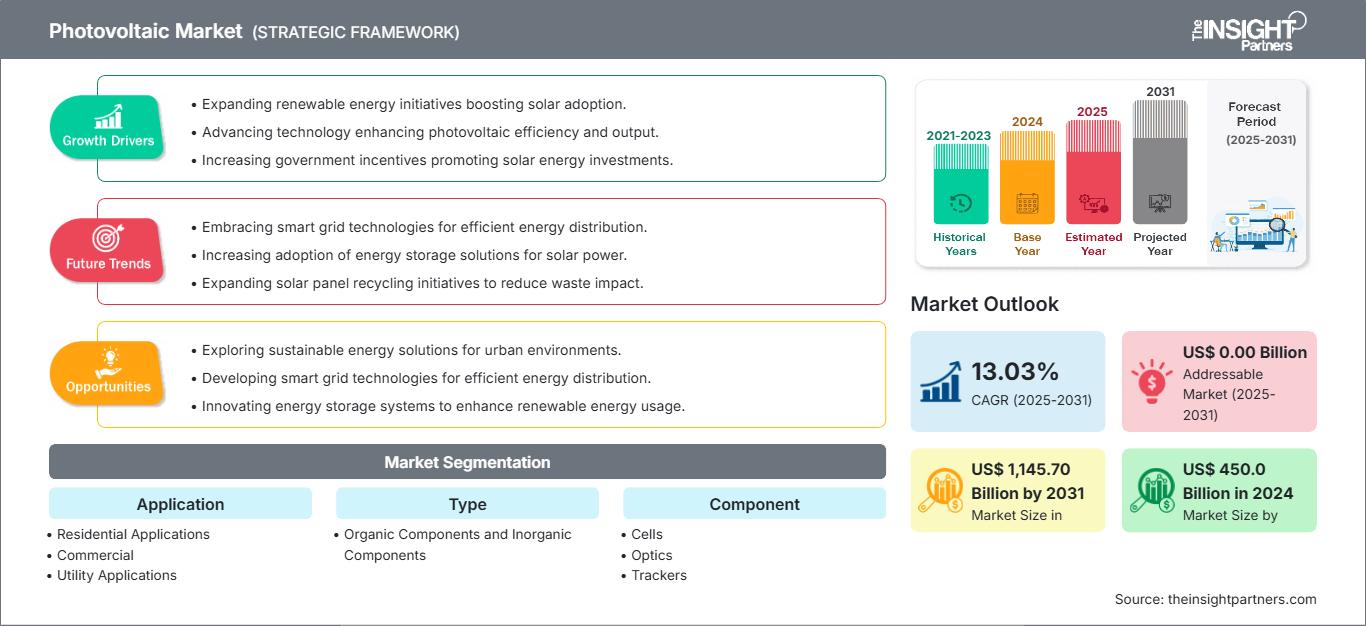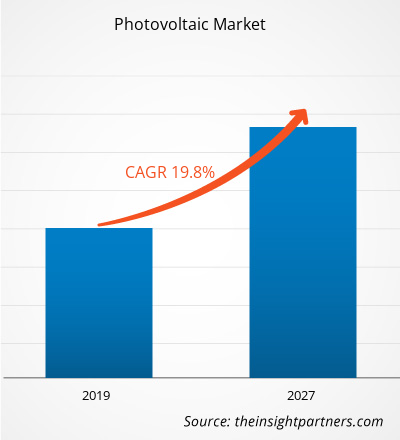Der Photovoltaikmarkt soll von 450,0 Milliarden US-Dollar im Jahr 2024 auf 1.145,70 Milliarden US-Dollar im Jahr 2031 anwachsen. Für den Markt wird zwischen 2025 und 2031 eine durchschnittliche jährliche Wachstumsrate (CAGR) von 13,03 % erwartet.
Im Zuge der technologischen Entwicklung und der Konzentration auf den wachsenden Trend zur Solar-PV-Technologie haben die deutsche und die spanische Regierung robuste politische Rahmenbedingungen geschaffen, darunter klare nationale Ziele, attraktive Anreize zur Förderung des Verbrauchs und integrierte Pläne zur Förderung der technologischen Entwicklung und der Einführung von PV-Technologien in der Solarenergie und zur Förderung des Wachstums des Photovoltaikmarktes. In der Asien-Pazifik-Region wurden von den Regierungen mehrere Initiativen ergriffen, um die Kosten der Gesamtanlage zu minimieren und die weitreichenden Vorteile einer netzunabhängigen Option für die Elektrifizierung ländlicher Gebiete zu maximieren. Gleichzeitig wurde der Fokus verstärkt auf nachhaltige Umweltbedingungen gelegt. Darüber hinaus haben mehrere Länder, wie beispielsweise China, Richtlinien zur Steigerung des Produktionsniveaus von Photovoltaik-Solarenergie erlassen. Somit tragen die oben genannten Faktoren zum Wachstum des Photovoltaikmarktes bei.
Photovoltaik (PV)-Energie wächst rasant und trägt einen bedeutenden Teil zur Energiebilanz der Stromsysteme der Wirtschaft bei. Diese Systeme haben sich als ausgereifte Technologie für die allgemeine Stromerzeugung etabliert und treiben das Wachstum des Photovoltaikmarktes voran. Solarbetriebene PV-Systeme erzeugen jedoch Strom im Überschuss. Stromanbieter auf der ganzen Welt bieten Net Metering an, ein Verfahren, bei dem der überschüssige Strom, der von netzgekoppelten erneuerbaren Energiesystemen produziert wird, an den Stromzähler zurückgeführt wird. Dies vermeidet Verschwendung und verbessert die Energieverteilung nach Bedarf. PV-Systeme mit Netztechnologie machen etwa 99 % der installierten Kapazität aus, im Vergleich zu Inselsystemen, die Batterien benötigen. Batterielose, netzgekoppelte PV-Anlagen gelten als kostengünstige Lösung und benötigen weniger Wartung, was die Verbreitung von PV-basierten Produkten fördert und somit den Marktanteil der Photovoltaik steigert.
Darüber hinaus gelten netzgekoppelte PV-Systeme für Umsteiger auf Solarmodule als kostengünstige Möglichkeit, ihren gesamten Strombedarf zu decken. Die Installation von Inselsystemen ist zudem recht aufwändig und erfordert mehr Kapital und Platz als die von netzgekoppelten PV-Systemen. Daher wird die zunehmende Verbreitung von netzgekoppelten PV-Systemen das Wachstum des Photovoltaikmarktes weiter vorantreiben. Mit der zunehmenden Konzentration auf die Nutzung erneuerbarer Energien und dem Trend zur Energieeinsparung erweisen sich netzgekoppelte PV-Systeme als wirtschaftlich sinnvolle Option. Ihre Anwendbarkeit ist derzeit jedoch noch recht begrenzt und könnte in den kommenden Jahren zunehmen.
Sie erhalten kostenlos Anpassungen an jedem Bericht, einschließlich Teilen dieses Berichts oder einer Analyse auf Länderebene, eines Excel-Datenpakets sowie tolle Angebote und Rabatte für Start-ups und Universitäten.
Photovoltaikmarkt: Strategische Einblicke

-
Holen Sie sich die wichtigsten Markttrends aus diesem Bericht.Dieses KOSTENLOSE Beispiel umfasst Datenanalysen, die von Markttrends bis hin zu Schätzungen und Prognosen reichen.
Markteinblicke in die Photovoltaik: Zunehmender Einsatz von Photovoltaikfarben zur Nutzung von Solarenergie
Die Volatilität der Rohölpreise, Umweltbedenken im Zusammenhang mit Wasserkraft und die mit radioaktiver Strahlung verbundenen Risiken haben dazu geführt, dass die Energieversorgung zunehmend durch Solarenergie gedeckt wird. Technologische Fortschritte, der Fokus auf die Senkung der Installationskosten und die schnelle Nutzung der Photovoltaiktechnologie im Wohnbereich zählen zu den Faktoren, die den Einsatz der Photovoltaiktechnologie neu definieren. Im Zeitalter der zunehmenden Nutzung von Solarenergie ist die Einführung von Solarfarben eine bemerkenswerte Errungenschaft. Solarfarben, auch bekannt als Photovoltaikfarben, können auf jede Oberfläche aufgetragen werden, um Sonnenenergie einzufangen und in Strom umzuwandeln. Die Bestandteile der Farbe werden mit Milliarden darin suspendierter lichtempfindlicher Materialpartikel kombiniert, was dazu beitragen könnte, eine herkömmliche Farbe in eine Energiespeicherfarbe mit Superkraft zu verwandeln. Der Einsatz von Photovoltaikfarbe kann die Abhängigkeit von Metallen effektiv verringern und durch die Kombination von pn-Übergangsdiodenprinzip und thermoelektrischem Effekt elektrische Energie aus Sonneneinstrahlung erzeugen. Dies wird zu einer verstärkten Nutzung von Solarenergie führen und letztendlich das Wachstum des Photovoltaikmarktes vorantreiben. Unternehmen wie die Onyx Solar Group LLC streben die Weiterentwicklung der Technologie an, indem sie sich auf F&E-Aktivitäten konzentrieren und mit Instituten zusammenarbeiten, um Photovoltaikfarbe zu entwickeln und so das Wachstum des Photovoltaikmarktes voranzutreiben. Obwohl Solarfarben bzw. die Photovoltaik-Farbtechnologie derzeit noch in den Kinderschuhen stecken, dürfte sie in naher Zukunft an Bedeutung gewinnen. Mit dem Fortschritt und der Weiterentwicklung der Solarindustrie hat Solarfarbe hervorragende Chancen, eine sinnvolle Option zu werden. Die oben genannten Faktoren schaffen somit Chancen für den Photovoltaikmarkt.
Photovoltaik
Regionale Einblicke in den PhotovoltaikmarktDie Analysten von The Insight Partners haben die regionalen Trends und Einflussfaktoren auf den Photovoltaikmarkt im Prognosezeitraum ausführlich erläutert. In diesem Abschnitt werden auch die Marktsegmente und die geografische Lage in Nordamerika, Europa, Asien-Pazifik, dem Nahen Osten und Afrika sowie Süd- und Mittelamerika erörtert.
Umfang des Photovoltaik-Marktberichts
| Berichtsattribut | Einzelheiten |
|---|---|
| Marktgröße in | US$ 1,145.70 Billion by 2031 |
| Marktgröße nach | US$ 450.0 Billion in 2024 |
| Globale CAGR (2025 - 2031) | 13.03% |
| Historische Daten | 2021-2023 |
| Prognosezeitraum | 2025-2031 |
| Abgedeckte Segmente |
By Anwendung
|
| Abgedeckte Regionen und Länder |
Nordamerika
|
| Marktführer und wichtige Unternehmensprofile |
|
Dichte der Akteure auf dem Photovoltaikmarkt: Ihre Auswirkungen auf die Geschäftsdynamik verstehen
Der Photovoltaikmarkt wächst rasant, angetrieben durch die steigende Endverbrauchernachfrage aufgrund von Faktoren wie sich verändernden Verbraucherpräferenzen, technologischem Fortschritt und einem stärkeren Bewusstsein für die Produktvorteile. Mit steigender Nachfrage erweitern Unternehmen ihr Angebot, entwickeln Innovationen, um den Bedürfnissen der Verbraucher gerecht zu werden, und nutzen neue Trends, was das Marktwachstum weiter ankurbelt.

- Holen Sie sich die Photovoltaikmarkt Übersicht der wichtigsten Akteure
Komponentenbasierte Markteinblicke
Photovoltaikzellen bestehen aus zwei oder mehr dünnen Schichten Halbleitermaterial. Das am häufigsten verwendete Material in Photovoltaikzellen ist Silizium. Die Halbleiterzellen werden Licht ausgesetzt, um elektrische Ladungen zu erzeugen, die über Metallkontakte als Gleichstrom (DC) abgeleitet werden können. Daher wird die zunehmende Verbreitung von PV-Zellen den globalen Photovoltaikmarkt im Prognosezeitraum vergrößern.
Akteure auf dem Photovoltaikmarkt verfolgen Strategien wie Fusionen, Übernahmen und Marktinitiativen, um ihre Position auf dem Photovoltaikmarkt zu behaupten. Einige Entwicklungen wichtiger Akteure sind nachfolgend aufgeführt:
- Im Jahr 2021 eröffnete Royal Dutch Shell PLC seine 25-Megawatt-Solaranlage Qabas. Das Projekt besteht aus über 88.000 Solarmodulen und befindet sich auf einem 50 Hektar großen Gelände in der Freihandelszone Sohar im Norden Omans. Es trägt dazu bei, die CO2-Emissionen um rund 25.000 Tonnen pro Jahr zu reduzieren.
- Im Jahr 2021 wurde das 300-MW-PV-IPP Sakaka, das erste erneuerbare Energieprojekt des Landes im Versorgungsmaßstab, von ACWA Power zu einem Preis von 1,2 Milliarden Saudi-Riyal eingeweiht. ACWA Power erhielt den Projektauftrag zu einem Weltrekordtarif von 2,3417 US-Dollar Cent pro kWh (8,781 Halalas pro kWh).
- Historische Analyse (2 Jahre), Basisjahr, Prognose (7 Jahre) mit CAGR
- PEST- und SWOT-Analyse
- Marktgröße Wert/Volumen – Global, Regional, Land
- Branchen- und Wettbewerbslandschaft
- Excel-Datensatz
Aktuelle Berichte
Erfahrungsberichte
Grund zum Kauf
- Fundierte Entscheidungsfindung
- Marktdynamik verstehen
- Wettbewerbsanalyse
- Kundeneinblicke
- Marktprognosen
- Risikominimierung
- Strategische Planung
- Investitionsbegründung
- Identifizierung neuer Märkte
- Verbesserung von Marketingstrategien
- Steigerung der Betriebseffizienz
- Anpassung an regulatorische Trends






















 Kostenlose Probe anfordern für - Photovoltaikmarkt
Kostenlose Probe anfordern für - Photovoltaikmarkt